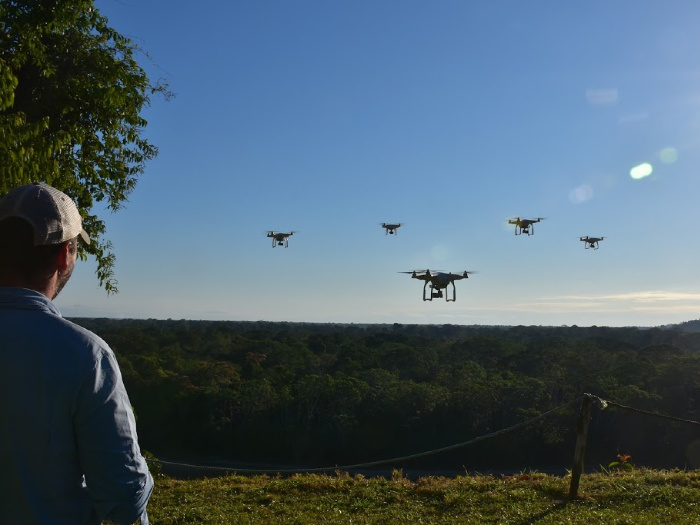MAAP (Monitoring of the Andean Amazon Project) is a project of DC-based Amazon Conservation, and its partners Conservación Amazónica (ACCA) in Peru, Amazon Conservation Team in Colombia, and EcoCiencia en Ecuador.
Launched in April 2015, MAAP is dedicated to presenting original analysis related to the dynamic new field of near real-time deforestation monitoring. Our goal is to present timely, high-impact technical reports in an easily accessible and understandable format.
The geographic focus of MAAP is the Andean Amazon, with an initial emphasis on Peru. In 2017, MAAP expanded coverage to Colombia in collaboration with Amazon Conservation Team. In 2018, MAAP also covered Ecuador, in collaboration with EcoCiencia. MAAP also is conducting preliminary work in Bolivia with partner ACEAA.

1) Rapidly document the most urgent deforestacion cases and identify the direct causes (drivers). MAAP has published over 75 of these case study reports as of early 2018 (see Archives page). Indeed, we aim to publish a new high-impact article (in both English and Spanish) every one to two weeks. We have documented the following major drivers of deforestation and degradation: gold mining, oil palm, cacao, small-scale agriculture, logging roads, and hydroelectric dams. We also recently published MAAP Interactive, an interactive map that shows the precise spatial location of documented deforestation drivers.
2) Better understand larger-scale deforestation patterns, hotspots, and drivers. We annually review all the case study reports and produce a synthesis report. The most recent is MAAP Synthesis #2. This synthesis represents a good starting point for policy makers, researchers, and journalists looking for a concise yet comprehensive overview of the deforestation situation of the region.
3) Improve policy and conservation action based on this cutting-edge technical information. Our primary audience is decision makers and government officials that may incorporate this information in official policy. An additional important audience is civil society, journalists, researchers, and the public, who together help create pressure to drive policy. We hope the end result is reduced deforestation. We have had a number of initial success stories, detailed here: Good News Deforestation Stories.
Given that the field of near real-time deforestation monitoring is young and dynamic, the MAAP methodology changes over time to incorporate the latest technology. Currently, the methodology combines four satellite systems: 1) Landsat-based early warning forest loss alerts (GLAD alerts), 2) high spatial and temporal resolution satellite imagery from Planet, 3) very high-resolution imagery from Digital Globe, and 4) radar imagery from the European Space Agency’s Sentinel-1 satellites. See the Methodology page for more details.
MAAP is currently supported by funding from:
It has also been supported by funding from:
Technical support is provided by:
Special thanks to the two groups that review each article before it is published: an internal Amazon Conservation committee, and an external collection of Peruvian NGOs belonging to the Articulación Regional Amazónica (ARA).
MAAP has a dynamic, evolving methodology designed to continuously incorporate the latest technology. Our overall goal is to use the best available technology to detect deforestation in near real-time, determine the direct drivers of the deforestation, and understand larger-scale deforestation patterns. The image below shows our basic methodology in graphical form. Further below, we briefly describe each step.
Starting in early 2016, WRI’s Global Forest Watch, in collaboration with the GLAD (Global Land Analysis & Discovery) lab at the University of Maryland, began publishing weekly GLAD deforestation alerts for Peru. While previous alert systems are based on 250-500 meter resolution MODIS imagery, GLAD alerts are based on 30 meter resolution Landsat imagery. For details on GLAD alert methodology, see: Hansen et al 2016, ERL 11:3. We analyze fresh GLAD alerts every week to locate emerging or expanding deforestation fronts in the Peruvian Amazon.
We also periodically analyze Terra-i deforestation alerts, particularly for areas outside of Peru. These alerts are based on 250 meter resolution MODIS imagery.
We also occasionally produce our own deforestation alerts, particularly for areas outside of Peru, using CLASlite software. CLASlite is an automated system that detects forest loss between any two Landsat images.
Our goal is to let these deforestation alerts guide our more targeted analysis described in the subsequent steps. We analyze these alerts in search of the most important emerging or expanding deforestation fronts in the Andean Amazon (with an initial focus on Peru). For example, we look for:
Once a potentially important or critical alert is identified, we manually verify the deforestation by directly analyzing 30 meter resolution Landsat images (note: these images are the basis of the GLAD and CLASlite alerts). We often construct a time-series of Landsat images to determine the precise time-frame of the deforestation event. Landsat images are freely available from USGS on the GloVis web portal: http://glovis.usgs.gov/. With its recent launch, we are also increasingly using Sentinel-2 imagery to manually verify deforestation alerts. Sentinel-2 imagery is freely available from the European Space Agency.
Once we have verified an important alert, we use high-resolution imagery to identify the deforestation driver. We have three primary sources of high-resolution imagery:
Note that this imagery is not freely available.
Analyzing this imagery, we are able to determine if the cause of deforestation is mining, agriculture, pasture, urban sprawl, or infrastructure (such as road or dam). Among agriculture, we can identify adult oil palm trees, but other crops are difficult to distinguish.